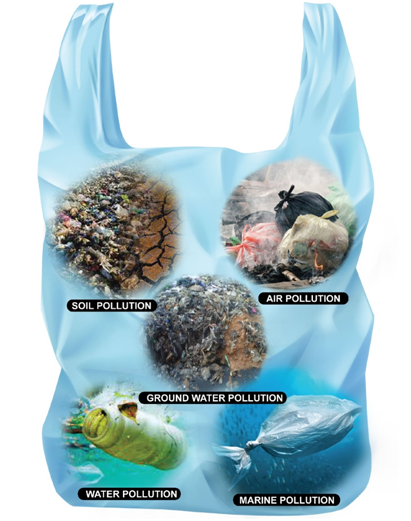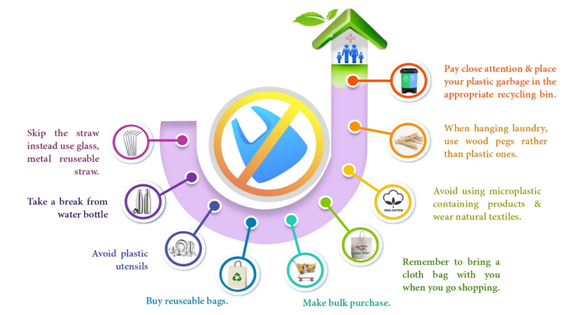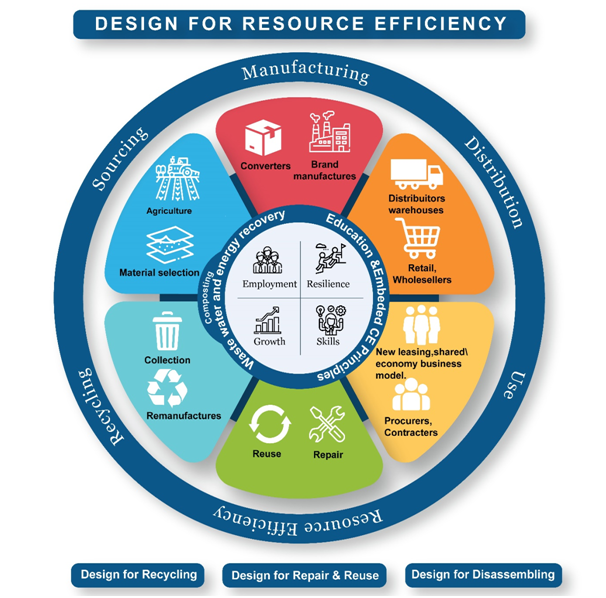Featured Science
Background
Over thepast fewdecades, it has become evident that plastic is considered a ubiquitous pollutant in nature. Plastic can be found in any ecosystem,i.e., land, sea, and freshwater, all over the globe. The omnipresence of plastic poses a significant threat to flora, fauna and human health.
In 1907, the first synthetic plastic, called Bakelite,marked the beginning of the global plastics industry. But it wasn't until the 1950s that the world's plastic production grew quickly. In the next 65 years, the amount of plastic made each year grew almost 200 times, to 381 million tonnes in 2015. This is about the same as the weight of two-thirds of the world's population.
Why plastic useis becomingpopular?
The increasing amount of plastic pollution in each ecosystem, which is caused by humans, has direct and indirect effects on the structure and function as well as on the services and values that the ecosystem provides (Figure 1).Single-use plastic has become popular in packaging because it keeps things fresh and safe and doesn't cost much.Recently, during the COVID-19 pandemic, the production of single-use plastics has also increased due to the increased use of protective gear such as masks and gloves.
Environmental and human health hazards from plastic pollution
Plastic pollution is a threat to the world because it adversely affects the aquatic and terrestrial ecosystems (Figure 1). In the environment, when exposed to the waves or sunlight, plastics break into microplastics,i.e., size <5mm. Plastic trash has not only been found in the open ocean but also in agricultural fields, soil, freshwater and marine shorelines, coral reefs, roadways, urban water runoff, freshwater lakes and streams. At eachfood chain level, aquatic animals interact with plastic waste and inadvertently eat it. Thus, plastics threaten primary producers such as algae, primary consumers such as zooplankton, and higher-order consumers such as turtles, seals, fish, whales, etc.Due to the presence of plastic pollution even in the terrestrial environment, wildlife is getting affected. Further, several studies have reported that microplastics are present among marine mammals, fish, birds and reptiles atadangerous level. For example, while terrestrial birds ingest microplastics, bees also incorporate anthropogenic waste into their nests.
Moreover, plastic waste can physically harm animals if they become entangled in it or consume it. It can also lead to injuries, asphyxiation, and malnutrition, ultimately resulting in death.Concern about the consequences of plastics on marine and terrestrial species is often expressed in scientific research, government documents, and the media.

Figure 1: Adverse impacts of plastic pollution on the environment
Plastic items are being recognized increasingly by the scientific community as acomplex contaminants that can produce a wide range of sub-fatal and lethal impacts.Due to its endurance, plastic has the ability to remain in the environment for hundreds to thousands of years. At the same time, its light weight enables it to be transported by air currents across vast distances. Moreover, when plastic is burnt, it releases harmful substances such as dioxins and furans, which pollute the air.
Plastics also have the ability to absorb toxins from the surrounding environment due to their hydrophobicity, affecting the fate of chemicals across environmental matrices. Plastics have also become part of our food chain and are promoting various human health diseases related to diabetes, obesity, cancer, hormone disruption,cancer, congenital impairments, hormonal abnormalities, decreased sperm counts, infertility, endometriosis, and immune damage. Additionally, exposure to plastic fumes can cause various breathing problems and feelings of vomiting, headache, etc.
Currently, plastic is produced in vast quantities and is predominantly used for single-use packaging intendedfor immediate disposal.The problem has worsened because of the sharp increase in production and consumption of single-use plasticand the spread of the "throw-away" culture. Waste management systems worldwide don't have enough space to get rid of or recycle waste plastic safely. This means that plastic pollution in the environment will only get worse.Therefore, there is an urgent need for effective and long-lasting ways to clean it up.
Whythere isa ban on single-use plastic items?
Appropriate strategies are needed to reduce plastic pollution further so that the milestone of zero plastic waste can be met. As a result of the introduction of a ban on non-biodegradable plastics by the government, alternatives to plastics have been encouraged. The focus is on plastics manufactured by combining non-biodegradable polymers with biodegradable plastics to minimize their impact on nature. After degradation, it breaks down into microplastics, significantly affecting the Earth's environment. Therefore, alternatives are being promoted and encouraged to reduce plastic pollution by banning the selected single-use plastic item with high nuisance value. Hence, a ban on single-use plastic items will promote Planetary Health.
Restricted items under the single-use plastic ban
As the name suggests, single-use plastic refers to disposable plastic objects after use. Single-use plastic is one of the most significant proportions of plastic produced and consumed, including packaging, face masks, shampoo bottles, coffee cups, and trash bags, etc.Single-use plastic includes cutlery (plates, cups, glasses, bowls, forks, knives, spoons, stirrers and straws) and thermocol cutlery. Apart from this, it also includes plastics used in decoration (wrapping, packing sheets, films, party bloopers and ribbons, etc.), polythene less than 75 microns in thickness, plastic sticks and single-use pens, etc.
In India, plastic bags having a thickness of less than 20 micrometers were made illegal in 2002. Plastic bags with a thickness of less than 50 micrometers were made illegal by a law that was enacted in 2005. In 2016, the state of Karnataka became the first in India to impose a total ban on plastic bags. The imposition of these plastic bags in India was carried out to avoid the congestion of the municipal drainage systems, particularly during the monsoon season. These regulations were also helpful in preventing sacred cows from accidentally consuming plastic bags while feeding, which would have led to their deaths. Further, plastic with 75-micron thickness will be effective from 31st September 2022 and 120 microns will be effective from 31st December 2022 to reduce the dependence on single-use plastic. Also, various steps can be taken at an individual level to reduce and minimize plastic pollution,as shown in Figure 2.

Figure 2: Role of the individual in reducing plastic pollution
Penalty provision under the single-use plastic ban
There is also a provision of punishment by the government on the use of single-use plastic, which is divided into different categories of its producers, storage, and distribution. This penalty ranges from ₹ 200 to ₹ 1000 on street vendors, ₹ 2000 to ₹ 10,000 on shopkeepers and ₹ 5000 to ₹ 5,000 on plastic makers. Apart from this, there is also a provision of a one lakh fine and up to 5 years in jail for repeated violations.
Government initiatives to curb plastic pollution
Plastics have become a transboundary threat to natural ecosystems and human health. Considering the environmental and human health hazards caused by plastics, separate rules on plastic waste were first introduced in 2016 and were revised again in 2018. These rules aim to reduce the harmful effects of plastics on animals, humans, and ecosystems. With this purpose, our honorable Prime Minister, ShriNarendraModiji, started the "Plastic Free India" campaign in 2018 from Red Fort.Also "Plastic Hackathon" was organized by the Government of India in 2021. The main objective of such a program is to make society aware of the harmful effects of plastics and promote proper plastic management so that plastic use can be minimized, as shown in Figure 3.For this, the Central Pollution Control Board has also created a mobile app so that you can know the harmful effects of plastic and spread awareness.
The Union Environment Minister of India also unveiled several green measures for plastic waste management. Further, the mascot "Prakriti" inspires the public to take eco-friendly steps in daily life. In addition, Prime Minister NarendraModi's commitment to eliminate single-use plastic was highly appreciated at the 'One Ocean Summit'.Apart from this, the Extended Producer Responsibility (EPR) portal for plastic packaging was also launched. It aims to improve accountability and transparency so that producers, importers, and brand owners comply with their EPR obligations.A mobile app was also released for complaints and redressal of single-use plastic. This app aims to inform everyone to check the sale, use and manufacture of single-use plastics in their local area and tackle the problem of plastic pollution.

Figure 3: Design for resource efficiency to reduce plastic pollution
Final words to eliminate Single Use Plastic
Government officials, scientists and industriesmust work together to prevent plastic pollution and promote sustainable development. At the same time, there is a need to promote modern techniques and scientific approaches to reduce the nature of plastic pollution and its impact on human health.
In order to eliminate plastic pollution as well as promote sustainable growth and support both green and blue economies, plastic pollution needs to be a top priority for both government officials and scientists. Recently, the Government of India has come up with the "SwachhSagar, SurakshitSagar campaign" a "75-day challenge" taken to clean up India's 75 coast areas.Apart from the global initiatives and policies, the government should initiate some buy-back policies and schemes for non-recyclable single-use plastic. Himachal Pradesh is following a buy-back policy and has shown positive results. Additionally, tax rebates or subsidies should be made on biodegradable/eco-friendly products. Moreover, it is quite difficult for the general public to differentiate between the various micron size plastic available in the market, so the regulation should be more precise and more straightforward for the general public to understand and follow. Also, there need to be modern and scientific approaches dealing with the techniques for preventing or minimizing the accumulation of plastic garbage in light of the current problem of plastic pollution, its severity, and its harmfulness.
For further queries-
Dr. Ravindra Khaiwal
Professor of Environmental Health,
Department of Community Medicine & School of Public Health
Post Graduate Institute of Medical Education & Research (PGIMER),
Chandigarh, 160012, INDIA
E-mail: khaiwal@yahoo.com
Web: http://www.pgimer.edu.in
https://scholar.google.co.in/citations?hl=en&user=DpYnGXEAAAAJ&view_op=list_works&sortby=pubdate
Disclaimer: This work has been submitted by the author. Any opinions, findings, conclusions or recommendations expressed in this article are those of the authors only.